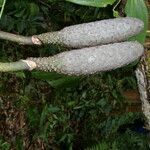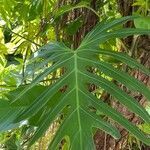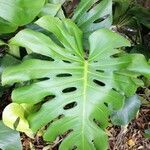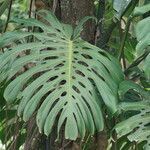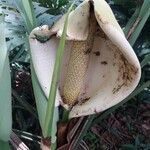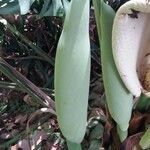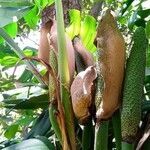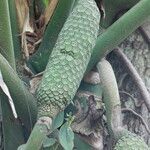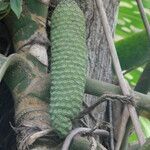A large, coarse, epiphytic vine, often climbing high on trees, the caudex terete, as much as 6 cm. or even more in diameter, the internodes often 7 cm. long or more, the nodes frequently emitting long aerial roots that dangle far below the caudex; petioles 1 m. long or less, 2-2.5 cm. in diameter, the sheath ending far below the base of the blade, the node as much as 3 cm. long; blades of the primary leaves small, cordate, entire, of the succeeding leaves ovate-cordate and sparsely perforated; blades of the adult leaves 40-60 cm. wide or larger, thick-coriaceous when dried, bright green and lustrous above, somewhat paler beneath, cordate-ovate in outline, almost regularly pinnatifid and with few or numerous perfora-tions along the costa, the segments linear or broadly linear, somewhat dilated toward the apex and cuspidate-acuminate; peduncles 10-15 cm. long, 1-1.5 cm. thick; spathe coriaceous, broadly ovate, apiculate, 20-25 cm. long, 15-17 cm. wide when spread out, pale yellowish; spadix 17-20 cm. long, becoming thick and juicy in fruit; pistils turbinate; berries pale yellow, somewhat tinged with violet, 1 cm. long.
More
A woody climber with large leaves with natural holes. It attaches itself to trees by roots at the nodes and climbs up to 15-20 m high. The stem is stout and crooked. The have a few branches. The leaves are glossy green. The leaves are divided around the edge. The leaves are 30-90 cm across. Young leaves are usually on shorter stalks, smaller and entire. The flowers are lily like and green. It has long (20-40 cm) cone like fruit.
A tropical plant. It does best in rich, moist, well-drained soils. It suits a protected, shady position. It bears fruit between 700 m and 2300 m altitude in the equatorial tropics but the plant grows down to the coast. It is damaged by drought and frost. Seed need to be sown at a temperature between 18-24°C. The plant needs a temperature above 15°C. It suits hardiness zones 11-12. In XTBG Yunnan.
More
An epiphytic vine, growing in the branches of trees in moist or wet, mountain forests at elevations of 900-1,500 metres.
The fruit is edible. The fruit are encouraged to ripen evenly by putting in a paper bag in a fridge for 24 hours then ripening at room temperature. The very ripe fruit are eaten. The fruit pulp can be strained and used as a drink. CAUTION The unripe fruit have irritant crystals which sting the mouth.
It is easily propagated by cuttings. Stem cuttings with one or two nodes or eyes are used. These are placed horizontally in potting mix. Putting these in a warm place with bright light but not direct sunlight quickens rooting. It should have a trellis, tree or wall to climb against. Plants can be grown from seed. Fruit can be ripened evenly by cutting them as soon as the base starts to ripen then wrapping them in paper for few days.
